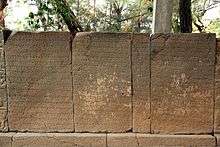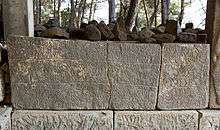Karatepe bilingual
The Karatepe bilingual (8th century BC), also known as the Azatiwada inscription, is a bilingual inscription on stone slabs consisting of Phoenician and Luwian text each, which enabled the decryption of the Anatolian hieroglyphs. The artifacts were discovered at Karatepe, southern Turkey by the archaeologists Helmuth Theodor Bossert (1889–1961) and Halet Çambel (1916–2014) in 1946.[1]
| Karatepe bilingual | |
|---|---|
| Material | Stone |
| Writing | Phoenician alphabet and Luwian hieroglyphs |
| Created | 8th century BC |
| Discovered | 1946 |
| Present location | Karatepe-Aslantaş Open-Air Museum, southern Turkey |




The stones featuring the Karatepe bilingual are situated along with many other statues and reliefs in stone at the Karatepe-Aslantaş Open-Air Museum, which is in turn part of the Karatepe-Aslantaş National Park.[2][3]
The inscription is known as KAI 26.
Call of Azatiwada
Placed at the fortress gates, the stones presenting the Karatepe bilingual inscription feature the "Call of Azatiwada" in the following text:[4]
- I am really Azatiwada,
- Man of my Sun, the servant of Thunder God,
- Rendered superior by Awariku, and the ruler of Adanawa,
- Thunder God rendered me Mother and Father of Adanawa city, and
- I am the one, who developed Adanawa city,
- And I expanded Adanawa country, both westward and eastward,
- And during my reign, I made Adanawa city tastes prosperity, satiety and comfort, and I filled the grain warehouses,
- I added horse to horse, shield to shield, army to army, everything for Thunder God and the deities,
- I defeated the feint of the feinters,
- I expelled country's bad men,
- I built palaces for myself, made my family comfortable, and ascended my father's throne, I made peace with all the kings,
- Also the kings respected me as ancestor for my justice, my wisdom and my kind heart,
- I built strong fortifications at all my borders, where bad men and gang leaders are,
- I, Azatiwada, trod all the people, who did not obey the House of Mopsus,
- I destroyed the fortifications there, I built fortifications so that people of Adanawa can live in peace and comfort,
- I bet strong kingdoms in the west my predecessors were not able to,
- I, Azatiwada, bet them, made them vassal to me, and resettled them within my borders in the east,
- And during my reign, I expanded the borders of Adanawa both westward and eastward,
- So that women nowadays wander spindling on the isolated trails, where men in the past feared to go,
- And during my reign, there was prosperity, satiety, peace and comfort,
- And Adanawa and Adanawa country were living in peace,
- And I built this fortress, and named it Azatiwadaya,
- Thunder God and the deities directed me to do this so that this fortress becomes protector of Adana Plains and the House of Mopsus,
- During my reign, there was prosperity and peace in the territory of Adana Plains, no one of Adanawa people was sabred during my reign,
- And I built this fortress, and named it Azatiwadaya,
- I placed Thunder God there, and offered it sacrifices,
- I sacrificed an ox every year, a sheep in the ploughing time and a sheep in the fall,
- I blessed Thunder God, it endowed me long days, countless years and huge power over all kings,
- And the folk, which settled in this country, owned ox, herd, food and drink, had plenty issue, and became servant to Azatiwada and the House of Mopsus thanks to Thunder God and the deities,
- When a king among the kings, a prince among the princes or a nobleman among the noblemen erases the name of Azatiwada from this gate, carves any other name; furthermore covets this city, destroys this gate built by Azatiwada, builds another gate in its place, and carves his own name on it, destroys this gate with the purpose of greed, hatred or insult then Sky deity, Nature deity and Sun of the universe and generations of all deities will wipe out this king, this prince or this nobleman from the earth,
- Only the name Azatiwada is eternal, forever like the name of the Sun and the Moon.
References
- "Karatepe". Hittite Monuments. Retrieved 2016-04-24.
- Scham, Sandra (2008). "From the trenches Off the Grid". Archaeology. 61 (4). Retrieved 2016-04-28.
- Mazzoni, Stefania (October 2008). "Karatepe-Aslantaş: Azatiwataya. Die Bildwerke". American Journal of Archaeology. 112 (4). doi:10.3764/ajaonline1124.Mazzoni.CS1 maint: uses authors parameter (link)
- "Karatepe-Aslantaş Azatawitaya ve Halet Çanbel" (in Turkish). Arkeoloji Dünyası. Retrieved 2016-04-26.
External links
- Hawkins, John David & Halet Çambel (1999). Corpus of Hieroglyphic Luwian Inscriptions: Karatepe-Aslantaş : the inscriptions. Walter de Gruyter. p. 122. ISBN 978-311-014-8701.
- Çambel, Halet & Asli Özyar (2003). Karatepe-Aslantaş: Azatiwataya. Die Bildwerke. Mainz: Verlag Philipp von Zabern. p. 164. ISBN 3-8053-3085-5.
| Wikimedia Commons has media related to Azatiwada inscription. |